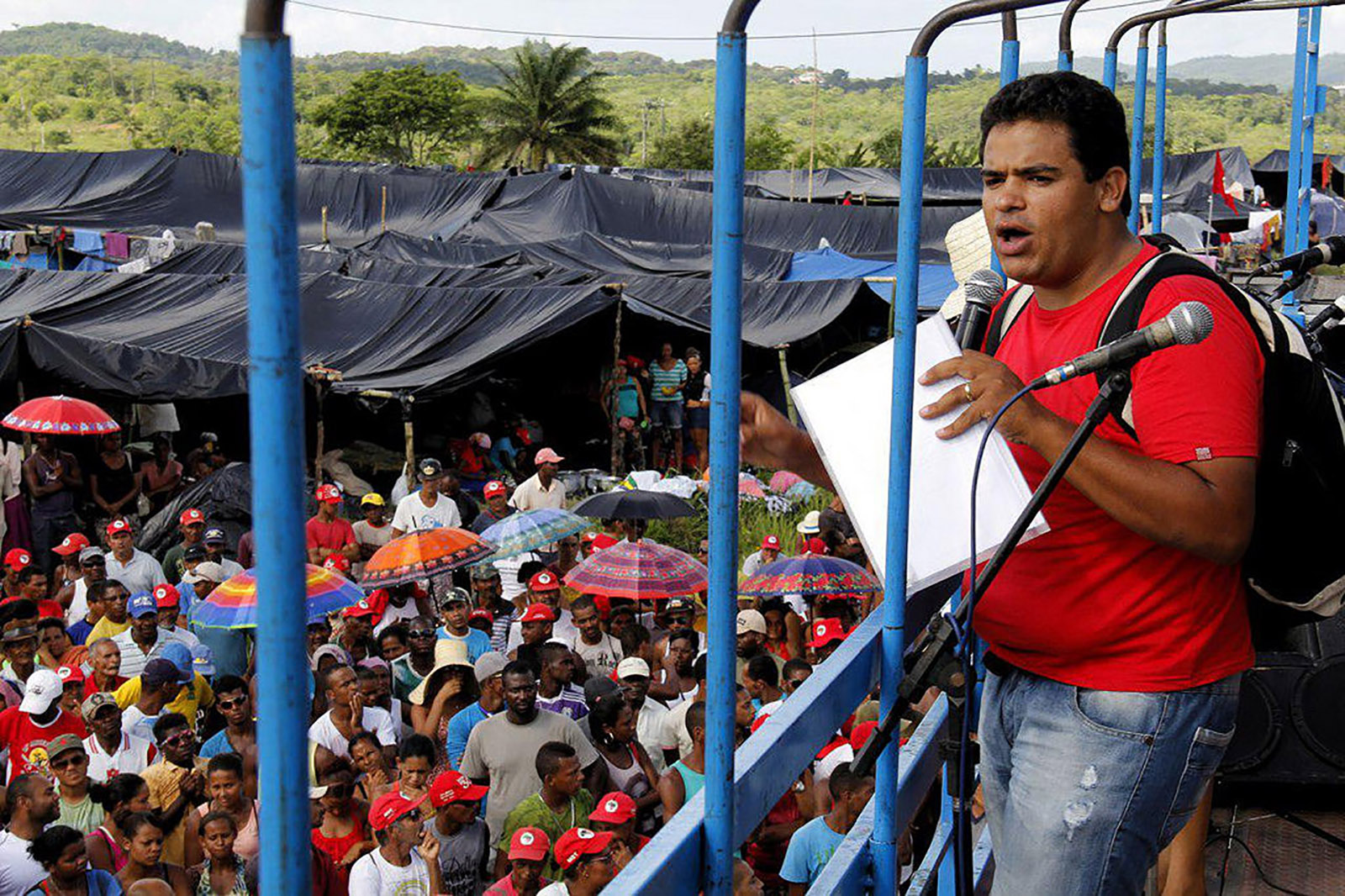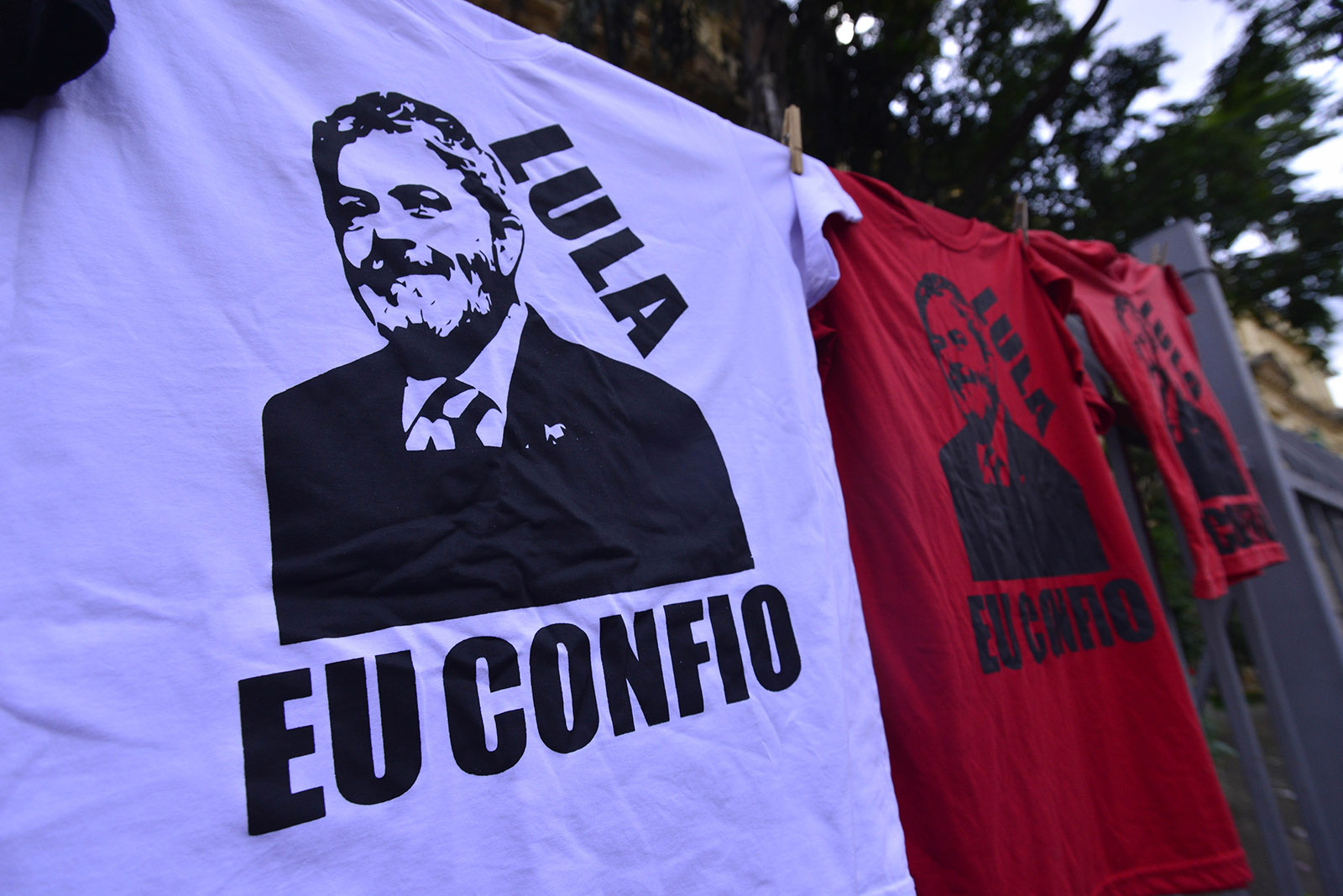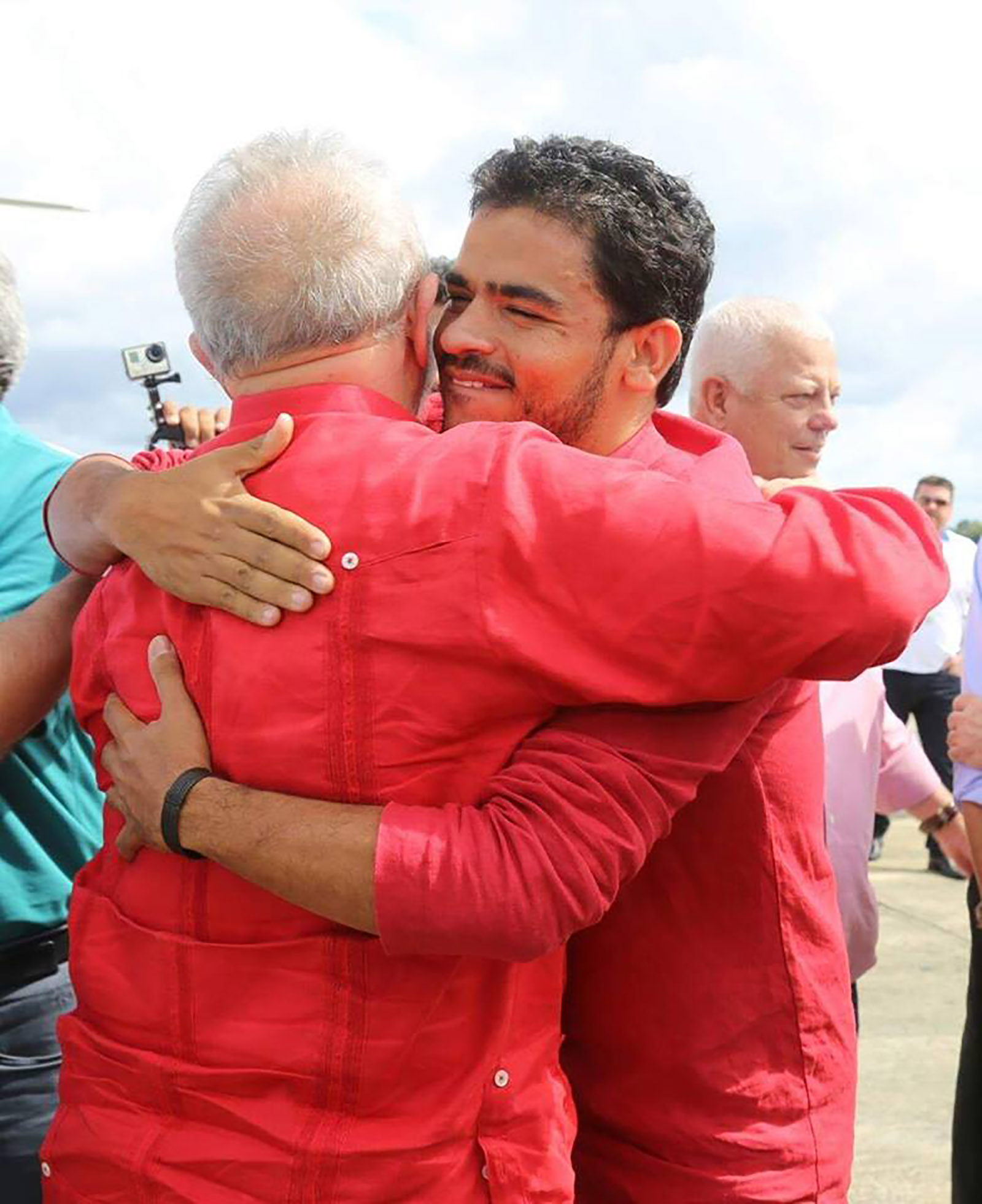Millions of Brazilians spent the evening of January 24 watching a courtroom on television. Three judges were scheduled to announce a verdict in the corruption case of Luiz Inacio Lula da Silva, the country’s former president. The judges delivered lengthy speeches, then a unanimous guilty verdict. Lula had illicitly attempted to receive an apartment by the sea, they ruled. It was 5:45 PM.
At 7:20, two men with guns arrived at the house of Márcio Matos. Márcio, thirty-three, lived on a small plot of parched turf in a settlement known as Boa Sorte, in the Iramaia municipality of northeastern Brazil. He was known for organizing protests through a group in Brazil called the Movement of Landless Rural Workers (MST). The armed men wore motorcycle helmets, which they refused to take off. They ordered Márcio’s six-year-old son to go into another room, then shot Márcio in the face and chest. Márcio’s son ran to tell a nearby rancher. Márcio died almost immediately.
I knew Márcio. I met him while carrying out research for a dissertation on social programs in rural Bahia state, where he lived. He impressed me as quiet and intense, inspiring respect, even a slight hush, when he arrived at the movement’s events. He was a rising star among the landless.
Within hours of the murder, poor farmers in the region of Vitória da Conquista, a city in Bahia, had begun to respond. Younger activists changed their Facebook profiles to Márcio’s picture. A veteran radical lawyer dashed off an angry editorial for a local news outlet. Someone made a banner with Márcio’s face on it, and it was hung, along with red flags, inside a large garage where his body was brought the next day for the wake. The day after that, Rosalvo José dos Santos, an itinerant musician and activist, pulled out his guitar to play a defiant hymn that began, “Come, let us weave our freedom / Strong arms that tear at the earth/ Underneath the shadow of our courage.” A crowd sang along, and then they buried Márcio.
Back in the United States, I followed the online conversations between movement activists, their allies, and government officials. Why had Márcio been killed? The police reported nothing stolen from the house. Márcio had been planning to run for state congress as a candidate of the Workers Party, the same party that Lula had led. Had the assassin been emboldened to act by news of the verdict against Lula? The police promised a prompt investigation.
The crime’s meaning, however, extended beyond the limits of a police inquiry. The murder of Márcio belongs to a new wave of political violence in Brazil’s countryside. Rural assassinations are on the rise, and these assassinations take place against a background of economic crisis and political malfeasance. As corruption trials generate a crescendo of public attention on law and order, the countryside becomes bloodier. In this respect, the two events of January 24—Lula’s conviction and Márcio’s death—were twin symbols of the Brazilian state in 2018, demonstrating both its strength and its shortcomings. Brazil’s government could prosecute its ex-president but not protect its own people.
Big landowners hold about 45 percent of Brazil’s countryside, while small farmers own just 2.3 percent. This concentration of resources in the hands of a wealthy few derives from the country’s history of slavery and the mass deaths of indigenous peoples. The result, today, is chronic tension between those who have land and those who don’t.
At age twelve, Márcio, the son of a progressive mayor and a left-wing teacher, intervened in this history: he joined the MST. The movement assembles a wide range of people, from sharecroppers to domestic servants, from field laborers to unemployed construction workers, all of them in search of land. Through the MST, they organize as squatters to occupy large plantations. They build huts on unused fields and live there, demanding land reform, until the police carry out an eviction. Often, after the eviction, the landless people move their camp to the side of a nearby highway.
Brazil’s constitution includes a land rights provision, so the movement sometimes succeeds in winning land for the landless. Since 1988, nearly 400,000 families have been resettled by a federal agency, which uses powers of eminent domain to split up large landholdings, compensating their former owners. In 2016, 120,000 additional landless families were camped in huts waiting for land allocations.
Advertisement
Over the past three years, these families have faced growing threats. A political and economic crisis in the country has led to a surge of renewed attacks by landed interests on rural activists. A church-affiliated nonprofit, the Pastoral Land Commission, has been tracking the upswing in violence. In each of the economically prosperous years from 2006 to 2013, there were never more than thirty-five killings associated with land conflict. Then came the start of the recession, followed by the impeachment of Dilma Rousseff, Lula’s Workers Party successor as president. Rural violence rose: in 2015, forty-seven people died in land conflicts, the highest figure for twelve years. In 2016, fifty-eight people were killed. From January to September 2017, the Pastoral Land Commission reported sixty-one killings. The death of Márcio belongs to this trend.
But why Márcio? He was a prominent leader of the landless movement and had served as a member of the nationwide coordination team. At the time of his death, though, he did not appear to be involved in any especially contentious MST campaigns, and he was not participating in any land occupations. In fact, he had stepped down from the coordination team in order to work as an administrator at a small-town city hall. Why, then, did he become a target?
One way to answer that question is to compare the killing of Márcio to the many similar attacks on landless people. The details of Márcio’s assassination fit a pattern of violence against small farmers in Brazil. Such killings are intended to send a message. In the region where Márcio lived, that message had special force because it recalled the case of a local leader named Fábio Santos.
*
Fábio dos Santos Silva was nine years older than Márcio, and he came from another town in Bahia a few dozen miles away, where a progressive priest had inculcated rural people in the gospel of Liberation Theology. Fábio, deeply influenced, became a Catholic landless leader. When I met him, he was a teacher, running classes at a small schoolhouse on an MST land settlement. Fábio himself lived at the settlement, among his pupils, in a white-painted home beside a forest, beyond the edge of town.
Like Márcio, Fábio organized protests for land reform. In 2012, he ran for city council as a member of the Workers Party, losing the election but placing his name and face on posters. Fábio’s dream, one of his neighbors told me, was to become mayor of the town.
On April 2, 2013, Fábio went into town to see if his children’s government benefits had arrived for the month. As he drove, his small black Fiat was overtaken by a motorcycle, and someone from the motorcycle fired seven shots into the vehicle. Fábio died quickly. His wife and daughter, seated next to him in the car, both survived.
No one has yet been brought to trial for Fábio’s killing; and, thus far, Márcio’s remains unsolved. Other leaders of the landless, however, understand Fábio’s murder as an act of intimidation in response to his activism. Specifically, one farmer told me, local people believe that a group of large landowners took up a collection to pay an assassin—something that Fábio knew about because, I was told, one of the landowners warned Fábio that he himself had contributed to the pot.
This practice fits into a tradition in Brazil so familiar and longstanding that it has its own vocabulary. There are mandates (those who order the crime) and executores (those who carry it out); there are propinas (the payments for the crime) and pistolagem (the use of guns to kill or threaten). The pattern has been well-documented in the few cases the legal system has pursued. In 2015, a Brazilian court found that Syngenta, a transnational agribusiness corporation, was responsible for hiring the private militia group that killed an MST leader named Valmir “Keno” Mota de Oliveira. State prosecutors have also accused a landowner in Colniza of ordering the torture and murder of Pastor Sebastião Ferreira de Souza, from the Assembly of God Church, and eight small farmers on April 19, 2017. And on July 3, 2017, a prosecutor accused a landowner and others of paying for the assassination of Fábio.
In the killing of Fábio, as in Márcio’s death, the attack may not have taken place in conjunction with a specific land conflict. It seems to have been directed, in a more general sense, against a prominent figure whose personal visibility would amplify the news of the crime. Both Fábio and Márcio had recently entered electoral politics, which further raised their profiles. They represented the landless movement and its ambition to walk in the halls of power. The crimes appear to follow a simple, grim logic: kill the leaders.
Advertisement
By murdering activists who were striving to cross into mainstream politics, the assassins send a message that is much more specific than a general warning against landless protest. The message is that landless people should avoid becoming leaders. In Márcio’s case, that message had special salience on January 24, the night when Lula, Brazil’s iconic working-class leader, was humiliated in a courtroom. Local landless farmers heard and understood what the killing communicated. Two days after Márcio’s death, I corresponded via Facebook with a local MST activist who served in a leadership position as the director of a cluster of land settlements. “If they wanted to shake us,” she told me, “they succeeded.”
*
The killings of Márcio and Fábio are part of a broader shift to the right in Brazilian politics. This shift, in retrospect, can already be perceived in the events of late 2013.
After Fábio’s death, local landless farmers began a series of protests calling for an investigation. These had an unanticipated result. On September 10, 2013, three hundred farmers from the MST marched into the ground floor of the State Public Safety Headquarters in the state capital. They waved their hoes in the air, in keeping with MST tradition, and called for a resolution to the investigation of Fábio’s murder. Since the state governor belonged to the Workers Party, the building was assumed to be relatively friendly territory for the landless movement. The reception, however, was hostile.
Ari Pereira, the state’s Vice-Minister for Public Safety, stood on an upper floor looking down at the crowd. He drew a pistol and fired it three times. No one was injured by what the state press office would later describe as a warning shot. Nonetheless, landless supporters were shocked to see an official in the government they considered an ally threatening a crowd of protesters with a gun.
The incident was one more indication of a problem evident throughout the country: the Workers Party’s governing coalition was fraying. In Brazil, political leaders typically strive for what they refer to as conciliação, a state of compromise and contentment in which the major players put on at least an appearance of social harmony. This meant, for the Workers Party, maintaining friendly relations with the MST while negotiating agreements acceptable to business interests. During the most successful years of the Lula presidency, the practice of conciliação succeeded in tamping down rural political violence. Land conflict assassinations, which had resulted in seventy-one deaths in 2003, killed twenty-four people in 2009.
The Workers Party did not achieve this reduction by confronting assassins with police action or prosecutions. Those have remained vanishingly rare in Brazil. Over the past thirty-one years, some 1,834 people have died in land conflicts, but only 112 cases have gone to trial. Instead, the Workers Party government redistributed at least some land and created an impressive array of social policies designed to alleviate suffering among Brazil’s poorest. These included Bolsa Família, the celebrated program of cash transfers that reaches a quarter of the nation’s families, and the Programa de Aquisição de Alimentos, which pays small farmers to produce food for school lunches. Tensions decreased in the countryside, and the number of land occupation protests dropped from 496 in 2004 to 252 in 2008.
Such was the Workers Party model of conciliação. Relying on revenue from an ebullient economy driven by Brazil’s exportation of soy, iron ore, and other primary commodities to China, the party expanded the welfare state. When the country’s economic growth slowed down in 2012, conciliação began to fall apart. It has been replaced, in the countryside, by a conservative backlash and a surge in rural violence—unprovoked by any increase in landless activism. As the researcher Antônio Canuto recently pointed out, the number of land occupations has remained consistently low during the economic crisis. There were 194 occupations in 2016, down from 230 in 2013. It is assassinations, not land protests, that have nearly doubled over the past three years.
Rural bloodshed is one aspect of the broader political transition taking place across the nation. An increasingly conservative Congress is far more aligned with business and landowning interests. Moreover, Congress itself is no longer the center of attention. Following the impeachment of Dilma Rousseff, national politics is focused more on juridical than on legislative power. A federal police investigation known as Operation Car Wash has uncovered evidence of a multibillion-dollar bribery scheme, potentially involving all of the major political parties, at the state oil company, Petrobras. Detectives have also unearthed more mundane graft schemes. Indeed, it was one of these investigations that led to the case against Lula. (The case turns on whether or not Lula was responsible for a construction firm’s attempt to bribe him with an apartment that he never actually received; he is appealing the court’s ruling.)
Operation Car Wash signals a new emphasis in the exercise of state power: prosecutorial action, rather than welfare provision. The law-and-order state currently enjoys tremendous popularity. With more and more elected politicians facing allegations of corruption, judges and police emerge as the heroes of the day. The second top-grossing Brazilian movie of 2017 was called Federal Police: The Law is for Everyone.
As many in Brazil have come to associate “big government” with corruption, the country’s new emphasis on law-and-order has given some cover to a conservative challenge to the welfare state. Congress recently froze public spending for twenty years, and there are proposals to cut pensions and raise the retirement age. On rural issues, legislators are looking at plans to develop mining on indigenous territory and restrict the federal government’s power to redistribute land. The rhetoric is ominous. Jair Bolsonaro, a conservative front-runner in the campaign to become the country’s next president, made his feelings clear at a campaign stop. “Here I want to say to the MST scumbags,” he said, “that we’re going to give guns to agribusiness, we’re going to give guns to the rural producer, because the welcome mat for a land invader is a bullet, 247 caliber.”
The social geographer Ariovaldo Umbelino de Oliveira recently argued that waves of rural violence in Brazil tend to track major transitions in the nation’s political regime. There was an upsurge in conflict in the late 1980s, as the nation exited dictatorship and adopted a new constitution. Another spike in assassinations occurred after Lula’s election in 2002, which paved the way for the Workers Party’s welfare-state coalition. The renewed rise in bloodshed today, according to Oliveira, suggests that a new political shift is taking place, one whose outlines are still forming.
If welfare-state conciliação is fading, what would a new law-and-order coalition look like? Conceivably, law enforcement could achieve a goal that eluded the Workers Party: prosecuting both urban and rural violence—and thus preventing crimes like the assassinations of Márcio and Fábio. But in the Car Wash moment, attention is on corruption, not violence.
Brazil’s political and economic turmoil may amount to a crisis of self-definition in a nation where the “new middle class” has expanded dramatically over the past decade. Anti-corruption rhetoric is the bread and butter of middle-class politics. This politics feels novel, with politicians suddenly going to jail and judges releasing bribery records to the media. The fresh political dynamic, however, is accompanied, in the nation’s countryside, by the reassertion of a very old form of extrajudicial landed power. For the time being, then, legal zeal in Brasília is rising concomitantly with lawless assassination of people who lack power and fame. If they are to fulfill their professed dream of fairness, the anti-corruption reformers of the new law-and-order state will need to address this blind spot.
Márcio’s last Facebook post, on the morning of January 24, was a picture of him embracing Lula at a political event. Márcio posted the photo to show his support in anticipation of the verdict’s delivery later that day. In the picture, Lula and Márcio look alike, both wearing red shirts and with their arms wrapped around one another. But the two men have been given different types of justice. While Lula’s affairs are receiving forensic scrutiny, the investigation of Márcio’s death has so far uncovered nothing. In Brazil’s new political dispensation, it seems easier to find suspects for political bribery than for political murder.





